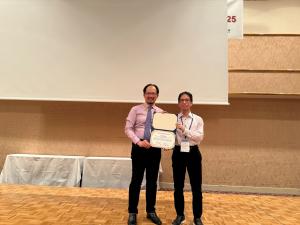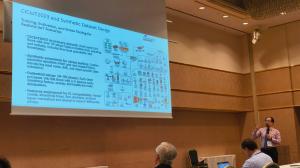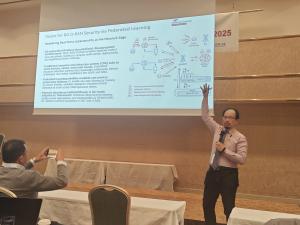Pioneering Professor Chang Develops Federated Learning Framework for 6G Network Security
Pioneering Professor Chang Develops Federated Learning Framework for 6G Network Security
BIRMINGHAM, WEST MIDLANDS, UNITED KINGDOM, October 23, 2025 /EINPresswire.com/ -- Professor Victor Chang from Aston University presents his novel FedAvgVChang algorithm at the IEEE CyberSciTech / DASC / PICom / CDBCom 2025
Premier Hotel, Hakodate City, Hokkaido, Japan, October 21-24, 2025. This federated learning system keeps data private in next-generation wireless networks and reduces the time to respond to cybersecurity threats by 44%. A 97% detection accuracy in industrial testing demonstrates the risk, which is a big step forward as billions of gadgets prepare to connect through 6G networks. His experience managing complex IT projects will support the organisation's digital transformation.
6G and Open Radio Access Networks (ORAN) provide us access to networks that we have never had before. Smart factories, self-driving cars, and medical devices are constantly communicating with each other. But the present security measures aren't enough. The central servers can't handle the amount of data anymore. Privacy rules make it harder to share information. Attack rates are higher than reaction times.
Chang revised the story. His method spreads knowledge worldwide after it is learned in one place.
While doing tests in the UK and Japan, and possibly Taiwan soon, Professor Chang said, "Imagine a hospital network is compromised. Patient monitoring finds problems. Each gadget performs its own threat analysis, so it doesn't send medical data to other computers. The security measures are the only things shared; patient data is never shared".
Three improvements make FedAvgVChang work better. First, quality-weighted aggregation ranks updates based on their reliability and speed. Second, even if devices fail during the procedure, dropout resilience ensures the results are correct. Third, explainability modules, which are very important for regulatory evaluations, explain why certain risks set up signals and suggest ways to improve.
The numbers in the data tell the narrative. Compared to typical methods, which take 32 training iterations, only 18 are needed to get the desired accuracy. The time required to communicate has been cut by 56%. Edge devices can perform a full threat analysis in 0.8 seconds on PCs costing roughly £50.
The architecture shows how the real networks are set up. Local edge processing finds immediate threats. Regional fog networks work together to protect areas. Global cloud orchestration enforces policies without touching raw data. What European privacy legislation is in effect? Content. What about the privacy of Chinese data? Kept safe. What are the standards for compliance in the United States? City.
"Security through obscurity failed years ago," Chang said. "That's why we're releasing this as open source. Let researchers worldwide strengthen it. Let regulators verify it. Real protection comes from transparency."
The audience, including senior IEEE members and Fellows, recognized Chang's practical impact for demonstrating this important research and innovation in 6G. His portfolio shows something rare in academia: delivery, consistency, and reliability.
Due to HIPAA and GDPR regulations, healthcare networks need to localise their data. Patient records stay within the institution's bounds, but threat patterns spread, which can help him with his work in the UK and Taiwan. Moreover, energy efficiency measures demonstrate a 60 percent reduction in WAN traffic during peak detection periods. Edge processing eliminates the need to send data back to the cloud. According to a carbon footprint analysis, each deployment reduces CO2 emissions by 0.4 tonnes per year, in line with ISO 14001 environmental goals. All of them would show how energy-efficient his solutions are.
Healthcare networks require data locality due to HIPAA and GDPR constraints. Patient records remain within institutional boundaries while threat patterns propagate, which can be helpful for his contributions in the UK and Taiwan. Moreover, energy-efficiency measurements show up to 50 percent reduction in WAN traffic during peak detection periods. Edge processing eliminates the need for backhaul to cloud infrastructure. Carbon footprint analysis indicates a 0.4-ton reduction in CO2 per deployment annually—aligning with ISO 14001 environmental targets. All these would demonstrate the strong energy efficiency of his solutions.
His research contributions are as follows. First, he has demonstrated high accuracy, consistency, and low latency across different test environments. Second, his algorithms can ensure a high level of data quality, handle data size and communication latency, and achieve a better fit between edge, fog, and cloud devices. Third, he has demonstrated the privacy benefits of federated learning in the forthcoming 6G era, as well as the role of AI explainability in increasing malware detection.
As a humble man who keeps learning, he remains a passionate, helpful, and dedicated scientist, researcher, consultant, mentor, and professor, driving technology forward, making it user-friendly and adaptable across different scenarios and organizations, and setting himself an example for others to follow.
Yulin Yao
Top Applied AI & Data Scientist, Aston University
email us here
Legal Disclaimer:
EIN Presswire provides this news content "as is" without warranty of any kind. We do not accept any responsibility or liability for the accuracy, content, images, videos, licenses, completeness, legality, or reliability of the information contained in this article. If you have any complaints or copyright issues related to this article, kindly contact the author above.



